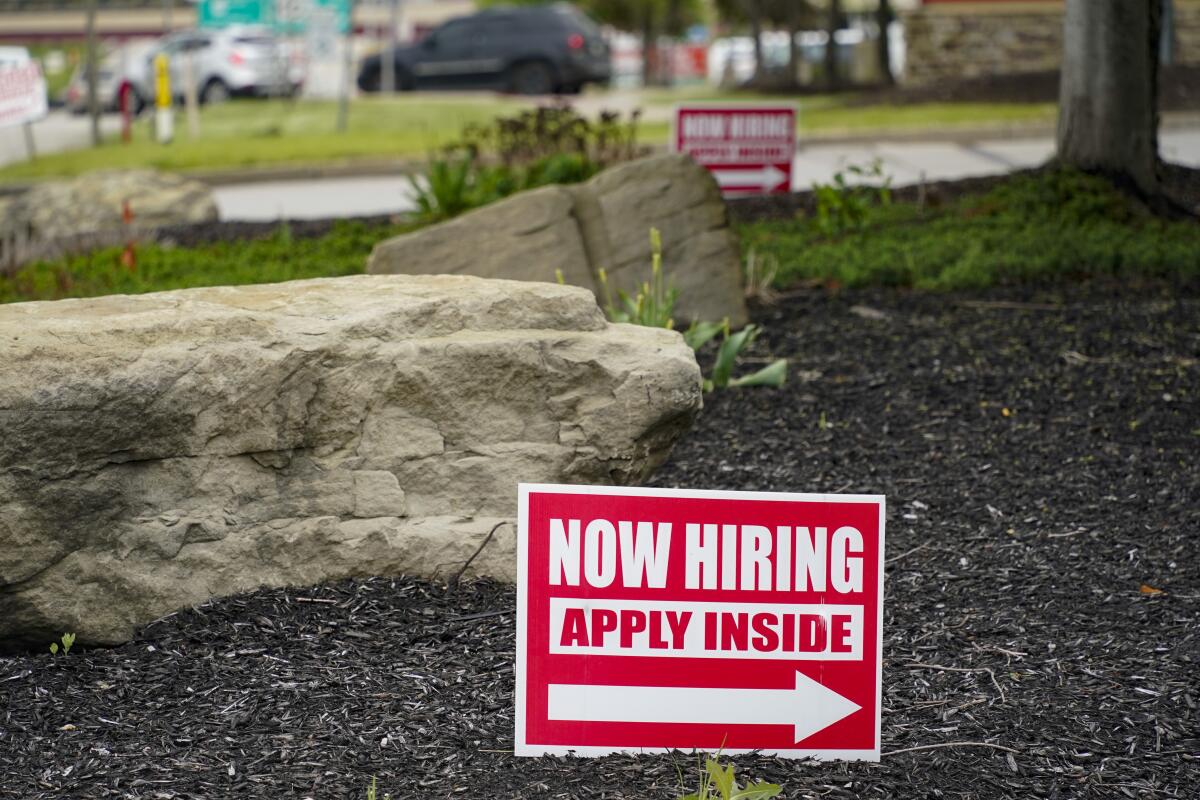U.S. hiring accelerated in June as labor market heats up

- Share via
WASHINGTON — In an encouraging burst of hiring, America’s employers added 850,000 jobs in June, well above the average of the previous three months and a sign that companies may be having an easier time finding enough workers to fill open jobs.
Friday’s report from the Labor Department was the latest sign that the reopening of the economy is propelling a powerful rebound from the pandemic-induced recession. Restaurant traffic across the country is nearly back to pre-pandemic levels, and more people are shopping, traveling and attending sports and entertainment events. The number of people taking flights each day has regained about 80% of its pre-COVID-19 levels. And Americans’ confidence in the economic outlook has nearly fully recovered.
The report also suggested that American workers are enjoying the upper hand in the job market as companies, desperate to staff up in a surging economy, dangle higher wages. In June, average hourly pay rose a solid 3.6% compared with a year ago — faster than the pre-pandemic annual pace. In addition, a rising proportion of newly hired workers are gaining full-time work, as the number of part-time workers who would prefer full-time jobs tumbled — a healthy sign.
Speaking at the White House, President Biden touted the job gains and suggested that his economic policies, including a $1.9-trillion economic relief plan that was enacted in March, were intended to make it easier for workers to find higher-paying jobs.
“The strength of our recovery is helping us flip the script,” Biden said. “Instead of workers competing with each other for jobs that are scarce, employers are competing with each other to attract workers.”
The Republican National Committee responded by noting that job gains have been stronger in Republican-run states, where governors have moved to cut off a $300-a-week federal unemployment payment to try to prod more people to seek jobs.
Friday’s report showed that the unemployment rate rose from 5.8% in May to 5.9% in June. Despite the job market’s steady improvement, unemployment remains well above the 3.5% rate that prevailed before the pandemic struck, and the economy remains 6.8 million jobs short of its pre-pandemic level.
Employers in California and the U.S. are scrambling to fill jobs as the dust from the pandemic begins to settle. Just don’t call it a labor shortage.
With competition for workers intensifying, especially at restaurants and tourist and entertainment venues, employers are offering higher pay, along with signing and retention bonuses and more flexible hours. The proportion of job advertisements that promise a bonus has more than doubled in the last year, the employment website Indeed has found.
Those inducements are gradually drawing more workers off the sidelines and making a modest dent in the labor shortage. The proportion of Americans in their prime working years — ages 25 to 54 — who are either working or looking for work rose at a solid pace, though it remains below pre-pandemic levels.
Hiring in June was particularly strong in restaurants, bars and hotels, which collectively absorbed the brunt of the layoffs from the recession. Those businesses added 343,000 jobs. Governments added 188,000 positions, mostly in education. And hiring by retailers picked up, with 67,000 jobs added.
Yet there are still factors holding back many people from taking jobs. About 1.6 million people said they didn’t look for work in June for fear of contracting the virus, though that figure dropped from 2.5 million in the previous month. And 2.6 million people who were working before the pandemic have retired.
The number of advertised job openings reached 9.3 million in April, the highest in 20 years of data, according to the Labor Department. The employment website Indeed has said that job postings have increased still further since then.
A temporary $300-a-week federal unemployment benefit, on top of regular state jobless aid, may be enabling some people to be more selective in looking for and taking jobs. Roughly half the states plan to stop paying the supplement by the end of July in what proponents say is an effort to nudge more of the unemployed to seek jobs.
On Thursday, the government reported that the number of people who applied for jobless aid last week fell to 364,000, the lowest level since the pandemic began.
There are also signs that people are reevaluating their work and personal lives and aren’t necessarily interested in returning to their old jobs, particularly those that offer modest wages. The proportion of Americans who quit their jobs in April reached its highest level in more than 20 years.
Nearly 6% of workers who are in an industry category that includes restaurants, hotels, casinos and amusement parks quit their jobs in April — twice the proportion of workers in all sectors who did so.
A survey of manufacturers in June found widespread complaints among factory executives about labor shortages. Many said they were experiencing heavy turnover because of what they called “wage dynamics”: Other companies are luring their workers away with higher pay.
The struggle to fill jobs coincides with a swiftly growing economy. In the first three months of the year, the government estimated that the economy expanded at a strong 6.4% annual rate. In the April-June quarter, the annual rate is thought to have reached a sizzling 10%.
And for all of 2021, the Congressional Budget Office estimated Thursday that growth will amount to 6.7%. That would be the fastest calendar-year expansion since 1984.
In the meantime, consumer confidence rose in June, according to the Conference Board, and is nearly back to its pre-pandemic level. Americans also seem undeterred by recent price increases, with the percentage of consumers who plan to buy a home, car or major appliance all rising. Home prices increased in April by the most in 15 years.
Factory output is also expanding at a healthy pace, in part because companies are investing more in industrial machinery, aircraft and technology. Those investments could make workers more efficient in the coming years and boost longer-term growth.
More to Read
Inside the business of entertainment
The Wide Shot brings you news, analysis and insights on everything from streaming wars to production — and what it all means for the future.
You may occasionally receive promotional content from the Los Angeles Times.










